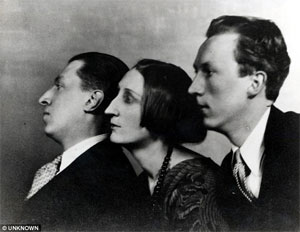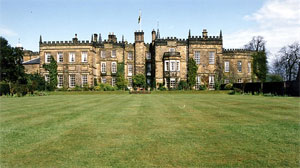New book Renishaw Hall examines the history of the Sitwell family
A romantic, enchanting house, where a puckish sense of humour is at play
Explores the family's history, including sale of ironworks in 1791
by Matthew Dennison
For The Daily Mail
18:26 EST, 30 July 2015 | UPDATED: 20:09 EST, 30 July 2015
NOTICE: THIS WORK MAY BE PROTECTED BY COPYRIGHT
YOU ARE REQUIRED TO READ THE COPYRIGHT NOTICE AT THIS LINK BEFORE YOU READ THE FOLLOWING WORK, THAT IS AVAILABLE SOLELY FOR PRIVATE STUDY, SCHOLARSHIP OR RESEARCH PURSUANT TO 17 U.S.C. SECTION 107 AND 108. IN THE EVENT THAT THE LIBRARY DETERMINES THAT UNLAWFUL COPYING OF THIS WORK HAS OCCURRED, THE LIBRARY HAS THE RIGHT TO BLOCK THE I.P. ADDRESS AT WHICH THE UNLAWFUL COPYING APPEARED TO HAVE OCCURRED. THANK YOU FOR RESPECTING THE RIGHTS OF COPYRIGHT OWNERS.
REINSHAW HALL
by Desmond Seward
(Elliott & Thompson £25)
On a long, rocky promontory, high above a hamlet on the southern border of Yorkshire's West Riding and the northern border of Derbyshire, stands a crenellated house of many windows.
This is Renishaw Hall, home to the Sitwell family for 400 years.
At first sight, it is not classically beautiful - the house has a forbidding, austere quality.

Successful siblings: (From left) Sacheverell, Edith and Osbert Sitwell
But step inside or wander through the Italianate gardens, which this year won the HHA/Christie's Garden of the Year Award, and you discover a different Renishaw: a romantic, enchanting, otherworldly house, where a puckish sense of humour is at play - a ghost who only appears to pretty girls, stealing cold kisses, statues of warriors fitted with spectacles, a notice removed from an aeroplane instructing users of a downstairs loo to ‘sit well back' before take off and landing.
Before World War II, artist Rex Whistler described it as ‘the most exciting house' he knew.
Historian Seward seamlessly links the history of this out-of-the-ordinary house to that of the family who built and continue to live in it. With the exception of the famous Sitwell siblings Osbert, Edith and Sacheverell, the Sitwells are not well-known. There are no famous Sitwell generals or politicians.
Despite - or because of - his name, Sitwell Sitwell embraced life with gusto. When a tiger escaped from a circus in Sheffield in 1798, it was Sitwell Sitwell who came to the rescue
Nowadays, few people read Edith's poetry, Osbert's autobiography or Sacheverell's art history. Yet anyone who has visited Renishaw will understand why Seward considered this stern, North Country house worth writing about.
The original house was built with the proceeds of a coal mine at Eckington Marsh. Soon after, George Sitwell began mining iron ore. He grew his business through exports to Virginia and the West Indies.
The English Civil War, with its demand for weapons, made him a wealthy man. By 1660, he was England's biggest manufacturer of iron nails and his furnaces were producing more than a tenth of the country's entire iron output. When his descendant Francis Sitwell sold the family ironworks in 1791, his huge income was worth half-a-million pounds, then a colossal sum. But Francis's undoubted business acumen did not stop him christening his son Sitwell.
Despite - or because of - his name, Sitwell Sitwell embraced life with gusto. When a tiger escaped from a circus in Sheffield in 1798, it was Sitwell Sitwell who came to the rescue. Using hounds from his own pack, he hunted the ferocious beast through the town's streets. He was later given a baronetcy.
Yet one thing that distinguishes the Sitwells is their consistent lack of interest in hunting and shooting.

The house itself: Renishaw Hall in Derbyshire
Today, Renishaw is not full of stuffed foxes' heads and paintings of horses. Instead, it is full of Italian paintings and hefty pieces of gilded Italian furniture that began their lives in doge's palaces and hilltop medieval castles.
If the effect is sumptuous, it came about for quite the opposite reason.
In the mid-19th century, Sir George Sitwell came close to bankruptcy. He auctioned Renishaw's contents, including the timber in the surrounding woods. He retreated to Germany, where the cost of living was lower, but even there was too poor to afford a fire in winter.
Renishaw might have been doomed, had it not been for the timely discovery of coal on the estate, and Sir George's descendants set about refilling the virtually empty house.
Another Sir George - the father of Edith, Osbert and Sacheverell - bought Italian baroque art, which was then unfashionable and undervalued.
Desmond Seward was a friend of Sir Reresby Sitwell, who died in 2009, and his remarkable wife Penelope.
This entertaining and elegant book is partly a lively celebration of Reresby and Penelope's restoration of Renishaw and their joint creation of one of the handsomest houses in England.
Matthew Dennison is author of Behind The Mask: The Life Of Vita Sackville-West (William Collins).
